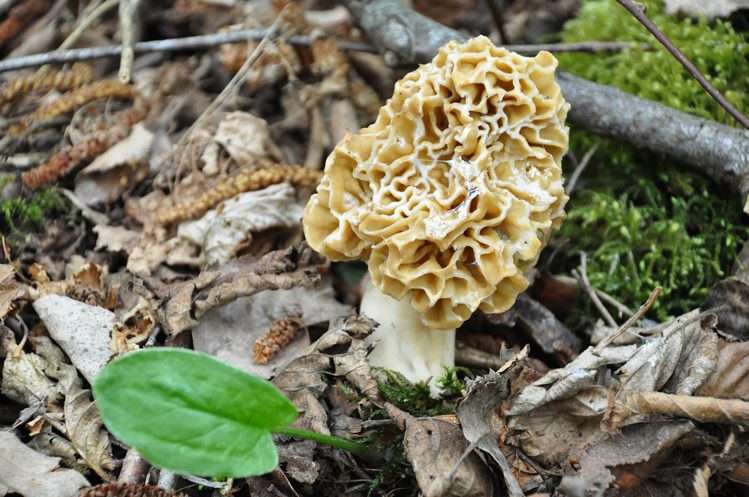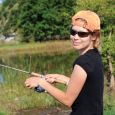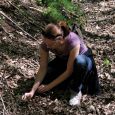The Gift of South Dakota
Subscriptions to South Dakota Magazine make great gifts!
Subscribe today — 1 year (6 issues) is just $29!
The Art of Mushroom Hunting
 |
| Morel mushrooms will soon begin to grow in South Dakota's river valleys. |
Thousands of South Dakotans are now waiting for a warming of the soil that will sprout mushrooms in forested fields and river bottoms.
When the time is right, people who normally complain about walking across the street for a loaf of bread will crawl through brambles, wade across mucky creeks, scratch under rotted leaves and climb barbed wire — all in the height of tick season — to collect a sack full of mushrooms.
I hadn't gone mushroom hunting since we escorted our elderly grandmother around the farmstead as she poked about for the fungi, so when longtime mushroomer Darold Loecker issued an invitation to search his favorite spot along the Missouri River I thought it might be a fun exercise.
"Meet me at the bait shop. And bring an extra pair of shoes," he said.
Grandma never needed extra shoes. That should have been the warning I needed. But I wasn't suspicious enough to ask.
Darold wasn't there yet when I got to the bait shop. The girl behind the counter asked if I was going fishing. She had a tub full of minnows.
"Mushroom hunting," I said confidently.
A Wonderbread man, who was filling the bakery shelf, said he found lots of mushrooms the night before. "But the ticks were thick. I had about 30 on me when I got home."
Just as I was trying to leave, Darold showed up. I mentioned the ticks. He just laughed. "Did you bring extra shoes?" he asked.
We got in Darold's pickup and as he turned the key he swore me to secrecy. Mushroomers, it seems, like to keep their favorite spots a secret. Unlike deer hunters, who will tell you the exact latitude and longitude where they bagged a big buck, mushroom hunters often won't even tell you what county they hunt.
Darold trusted me for some reason. And it wasn't long before we came upon some cottonwood trees in a river bottom. He gave me a bag and suggested I find a walking stick, which isn't hard to do in a forest of cottonwoods.
He said the stick serves three purposes: It can be a cane, a marker when you find a good spot and a probe in underbrush.
Off we went. My eyes were trained on the grassy ground. I found empty shotgun shells and Mountain Dew cans, but no mushroom.
After about five minutes, Darold called me over. He pointed to a little fungus with a brown, spongy head atop a 2-inch stem. "That's a morel mushroom. That's what we're looking for."
He instructed me how to pinch the mushroom off at ground level. I was more confident now that I knew what we were looking for. I walked even slower, looking under every brush by every log. Darold has discovered that mushrooms seem to sprout around downed trees and branches.
Darold found a few more. I was still looking for my first one. Then he started tailing me and every now and then he would say, "You just stepped over one!"
That was the motivation I needed to really watch the earth and, before long, I found a few without backtracking. At last I was a full-fledged mushroom hunter.
We had good success along the riverside. But mushroom hunters are explorers and Darold pointed to a tiny island, which was separated from us by a swamp of stale water and cattails.
''There'll be mushrooms there because nobody else will go there," he said. That's where the extra shoes came in handy. We put on our old sneakers and gingerly waded through the swamp to the island, where we found more pop cans but no mushrooms.
We returned to the riverbank, put on our dry shoes and resumed the hunt. In a few hours' time we filled several bags with morel mushrooms. I felt like a gardener who reaped a bounty without pulling a weed. And we only brushed off a half-dozen wood ticks.
It seemed too easy to be legal. But it is.
Since that mushroom hunt, I have tried to learn more about mushrooms by asking other veteran pickers for advice. As long as you don't inquire as to where they go, they are willing to talk. Here's some of what I've learned:
Don't use plastic bags when you hunt for mushrooms because they cause sweating and quicker deterioration. Use paper bags in the field, and wax paper or newspapers for wrapping.
Sandy soil (such as can be found along many rivers) is the best place to search early in the season because it warms earlier. The mushroom season usually arrives in mid-April in southeast South Dakota and may last only a week or two, depending on the weather. It may come later in northern South Dakota and has been known to extend to Memorial Day in the Black Hills.
If you are hunting mushrooms for the first time, be certain you are collecting edible fungi. Some are poisonous. The most popular South Dakota mushroom is the genus Morchella, commonly known as the morel. Guidebooks are available to help you identify your bounty. Veteran mushroom hunters are also happy to help.
Once you bring home a sack full of mushrooms, you'll wonder what to do with them. Most nutritionists would probably agree that mushrooms will never become a staple in the American diet. They are not easily digestible and should not be eaten in large quantities.
Furthermore they are fungi — closely related to athlete's foot, green stuff on old cheese and corn smut. Nutritionally, they are about as good as a leaf of lettuce.
But also remember that mushrooms can cost $100 a pound dried in some specialty stores. And the morel we commonly enjoy in South Dakota cannot even be grown in captivity. They only flourish in the wild.
When you bring your mushrooms home, be certain to look for tiny worms that sometimes crawl into the pitted crown of the morel.
Some people store their mushrooms by drying them on wire trays or screens and then storing the pieces in tightly closed jars. When water is added later, the mushrooms return to their original shape, texture and taste.
Others can mushrooms by heating them for about 15 minutes in water and then packing them in pint or half-pint jars. Add 1/2 teaspoon of salt and 1/8 teaspoon of ascorbic acid to each pint and fill the jars with boiling water to cover the mushrooms. Process in a hot water bath for three hours or in a pressure canner for 30 minutes at 10 pounds pressure.
When it comes to preparing the mushrooms for the table, it is a matter of preference. Many people simply slice them up for salads, sauces and omelets.
But a favorite style, especially in South Dakota bars, involves dipping mushroom slices in an egg batter and frying them quickly in butter, turning them to brown both sides.
Editor’s Note: This story is revised from the March/April 1993 issue of South Dakota Magazine. To order a copy or to subscribe, call (800) 456-5117.










Comments